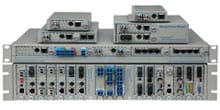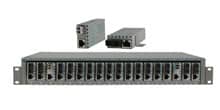- Products
- PoE Media Converters and Switches
- Ethernet & PoE Switches Product Selector
- Multi-Gigabit Ethernet and PoE Switches
- PoE PSE Commercial Switches
- PoE PSE Industrial Fiber Switches
- PoE Industrial Copper Extenders
- PoE Powered Media Converters
- PoE PSE Media Converters
- PoE Extenders & Injectors Product Selector
- Pluggable Transceivers Product Selector
- Single Pair PoE Products
- Product Lines

- iConverter Managed Multi-service Platform
- Copper to Fiber Media Converters
- Ethernet Media Converters
- 10 Gigabit Copper-to-Fiber
- 10/100/1000 Copper to 10 Gigabit Fiber
- 10/100/1000 Copper-to-Fiber with Integrated Management
- 10/100/1000 Industrial Copper-to-Fiber with Integrated Management
- 10/100/1000 Copper-to-Fiber with VLAN
- 10/100/1000 Dual Media Converter with VLAN
- Gigabit Copper-to-Fiber
- 10/100 Copper-to-Fiber with Integrated Management
- 10/100 Industrial Copper-to-Fiber with Integrated Management
- 10/100 Copper-to-Fiber with VLAN
- 10/100 Copper-to-Fiber
- Fast Ethernet Copper-to-Fiber
- Fast Ethernet Redundant Links
- 10Mbps Copper-to-Fiber
- 10Mbps Copper to Coax
- TDM Media Converters
- Serial Media Converters
- Ethernet Media Converters
- Fiber to Fiber Media Converters
- 10 Gigabit Fiber-to-Fiber Converter and Transponder
- 10 Gigabit Industrial Converter and Transponder
- SFP-to-SFP Fiber Converter and Transponder
- SFP-to-SFP Industrial Fiber Converter and Transponder
- Gigabit Fiber to-Fiber with 3 Rs
- 100/1000 Fiber-to-Fiber with 3 Rs
- Gigabit Fiber-to-Fiber
- Fast Ethernet Fiber-to-Fiber with 3 Rs
- Fast Ethernet Fiber-to-Fiber
- OC-3/STM-1 Fiber-to-Fiber
- OC-12/STM-4 Fiber-to-Fiber
- Carrier Ethernet Network Interface Devices
- CE 2.0 - 10G Demarcation NID
- CE 2.0 - 10G Demarcation and Aggregation NID
- CE 2.0 - 10/100/1000 Mult-port NID
- CE 2.0 - 10/100/1000 Mult-port NID with PoE
- CE 2.0 - 10/100/1000 8-Port NID
- SFP NID - Gigabit SFP NID
- microNID - 100/1000 compact NID
- CE 1.0 Service OAM - 10/100/1000 NID
- CE 1.0 Link OAM - 10/100/1000 Copper-to-Fiber NID
- CE 1.0 Link OAM - 10/100 Copper-to-Fiber NID
- CE 1.0 Link OAM - Gigabit Fiber-to-Fiber NID
- CE 1.0 Link OAM - Fast Ethernet Fiber-to-Fiber NID
- CWDM Multiplexers
- T1/E1 Multiplexers
- Ethernet Switch Modules
- Management System
- Chassis Options

- 1-Module Industrial Chassis

- RuggedNet Industrial Switches and Extenders
- Industrial PoE PSE Fiber Switches
- Multi-Gigabit Managed Industrial PoE+/BT Switches
- Multi-Gigabit Unmanaged Industrial PoE+/BT Switches
- 10G Managed 802.3bt PoE Switches
- 10G Unmanaged 802.3bt PoE Switches
- 10G Managed PoE+ Switches
- 10G Unmanaged PoE+ Switches
- 1G Managed PoE+ Switches
- 1G Unmanaged PoE+ Switches
- 1G Unmanaged 802.3bt PoE Switches
- 1G Managed 802.3bt PoE Switches
- Industrial SPE Switches
- Industrial Ethernet Switches
- Industrial PoE Copper Extenders
- Industrial Power Supplies

- OmniConverter Media Converter, Switches and Extenders
- PoE PSE Media Converters
- 10G Multi-Gigabit / Multi-Rate PoE Media Converter
- 10G Multi-Gigabit / Multi-Rate Media Converter
- 10/100 Multi-port PoE+ Media Converter
- 10/100 PoE+ Media Converter
- 10/100/1000 Multi-Port PoE+ Media Converter
- Industrial 10/100/1000 Multi-Port PoE+ Media Converter
- 10/100/1000 PoE+ Media Converter
- 10/100/1000 PoE++ 60W-100W Media Converter
- Industrial 10/100 Multi-port PoE+ Media Converter
- 1U Rack-Mount Shelf
- PoE PSE Compact Switches
- Multi-Gigabit Managed PoE+/BT Switches
- Multi-Gigabit Unmanaged PoE+/BT Switches
- 10G Managed 802.3bt PoE Switches
- 10G Unmanaged 802.3bt PoE Switches
- 10G Managed PoE+ Switches
- 10G Unmanaged PoE+ Switches
- 1G Managed PoE+ Switches
- 1G Unmanaged PoE+ Switches
- 1G Managed 802.3bt PoE Switches
- 1G Unmanaged 802.3bt PoE Switches
- Ethernet Switches
- PoE Copper Extenders
- Single Pair Ethernet (SPE)
- PoE Injectors

- miConverter Unmanaged Miniature Media Converters
- 10/100/1000 Copper-to-Fiber
- Industrial 10/100/1000 Copper-to-Fiber
- 10/100/1000 Ultra-Compact Copper-to-Fiber
- Gigabit Copper-to-Fiber
- 10/100/1000 Copper-to-Fiber PoE Powered
- 10/100 Copper-to-Fiber
- 10/100 Ultra-Compact Copper-to-Fiber
- 10/100 Copper-to-Fiber PoE Powered
- 18-Module Chassis
- Industrial 10/100 Copper-to-Fiber PoE Powered

- FlexSwitch Compact Switches
- Solutions
- Company
- Support
- How to Buy
Single Mode SFP vs Multimode SFP: Exploring the Differences

Single-mode SFP (Small Form-factor Pluggable) and multimode SFP are two types of optical transceivers used in fiber optic communication. The main difference between them lies in the type of optical fiber they are compatible with and the distance they can transmit data.
Understanding SFP Transceivers
SFPs are compact, hot-swappable devices used in networking equipment to transmit and receive data over optical fibers. They come in two primary types: Single Mode and Multimode, each tailored for distinct networking needs.
Single Mode SFP: Streamlining Long-Distance Communication
Single Mode SFP, also known as SMF (Single Mode Fiber), is engineered for long-distance communication. It utilizes a thinner optical fiber, typically with a core diameter of 9 µm. This smaller core reduces light dispersion, enabling data transmission over significant distances with minimal signal loss.
Characteristics of Single Mode SFP:
- Ideal for long-distance transmissions spanning tens of kilometers.
- Utilizes laser diodes for signal transmission.
- Offers higher bandwidth and longer reach compared to Multimode SFP.
- Suited for applications requiring high data rates and reliability.
Multimode SFP: Optimizing Short to Medium-Range Connectivity
Multimode SFP, on the other hand, is designed for shorter-range transmissions within data centers, campuses, or metropolitan areas. It employs a larger core diameter, typically 50 µm or 62.5 µm, allowing multiple light modes to propagate.
Characteristics of Multimode SFP:
- Suited for short to medium-distance transmissions, typically up to 550 meters.
- Utilizes LED (Light Emitting Diode) or VCSEL (Vertical Cavity Surface Emitting Laser) technology.
- Offers cost-effective solutions for intra-building or inter-building connectivity.
- It exhibits lower bandwidth and shorter reach than Single Mode SFP.
Differentiating Factors: Single Mode vs Multimode SFP
Now, let's compare Single Mode and Multimode SFP across various parameters to grasp their dissimilarities comprehensively:
-
Transmission Distance:
- Single Mode SFP: Suitable for long-distance transmissions, ranging from several kilometers to tens of kilometers.
- Multimode SFP: Designed for shorter distances, typically within a few hundred meters to a kilometer.
-
Bandwidth:
- Single Mode SFP: Offers higher bandwidth, making it ideal for applications demanding high data rates.
- Multimode SFP: Exhibits lower bandwidth compared to Single Mode, limiting its suitability for high-speed data transmission.
-
Cost:
- Single Mode SFP: Generally more expensive due to the sophisticated technology required for long-distance communication.
- Multimode SFP: Provides a cost-effective solution for short to medium-range connectivity needs.
-
Light Source:
- Single Mode SFP: Employs laser diodes for transmitting data, ensuring precise and efficient signal propagation.
- Multimode SFP: Utilizes LED or VCSEL technology, offering a less expensive yet effective means of signal transmission.
Here's a table summarizing the key differences:
| Feature | Single Mode SFP | Multimode SFP |
|---|---|---|
|
Core Size (microns) |
9 |
50 or 62.5 |
|
Wavelength (nm) |
1310 or 1550 |
850 |
|
Transmission Distance |
80km |
550m |
|
Cost |
High |
Low |
|
Applications |
Long-haul |
Short-haul |
Omnitron SFP transceivers
Omnitron SFP transceivers are a reliable and cost-effective solution for a variety of networking applications. Omnitron offers SFP transceivers in various types, including:
- Gigabit Ethernet: for up to 1.25 Gbps data transmission
- 10 Gigabit Ethernet: for up to 10 Gbps data transmission
- CWDM (Coarse Wavelength Division Multiplexing) and DWDM (Dense Wavelength Division Multiplexing): for transmitting multiple data channels on a single fiber
| Omnitron Optical Transceiver | Fiber Type | Connector Type | Transmission Distance | Operating Temperature |
|---|---|---|---|---|
|
- Dual fiber - Single Fiber - Multimode fiber |
LC/SC RJ-45 |
160 km |
- Comercial (0° C to +50° C) - Industrial (-40° C to +85° C) |
|
|
- Dual fiber - Single Fiber - Multimode fiber |
LC RJ-45 |
120 km |
- Comercial (0° C to +50° C) - Industrial (-40° C to +85° C) |
|
|
- Dual fiber - Single Fiber - Multimode fiber |
LC/SC |
150 km |
- Comercial (0° C to +50° C) - Industrial (-40° C to +85° C) |
|
|
- Dual fiber - Single Fiber - Multimode fiber |
LC/SC |
80 km |
- Comercial (0° C to +50° C) - Industrial (-40° C to +85° C) |
FAQs
Can I use multimode fiber with single-mode SFP?
Using multimode fiber with single-mode SFPs is not advisable due to compatibility issues. Single-mode SFPs are designed to work with single-mode fiber, which has a narrower core diameter and operates at different wavelengths than multimode fiber. Attempting to use them interchangeably can result in signal loss, degradation, and network instability.
Is multimode fiber cheaper than single-mode?
Generally, multimode fiber is cheaper than single-mode fiber. This cost difference arises from variations in the manufacturing process and materials used. However, other factors, such as transmission distance and bandwidth requirements, must be considered when determining the overall cost-effectiveness of your networking needs.
What is the minimum distance for single-mode SFP?
While the SFP itself might function at short distances, other equipment involved (like the switch) might have minimum distance requirements. Consult the documentation for your specific switch model. Very short connections can cause the signal to be too strong for the receiving SFP, potentially leading to errors. In such cases, an attenuator can be used to reduce the signal strength. It's crucial to consult with your network equipment provider for specific distance recommendations based on your setup.
In general, for very short runs (a few meters), multi-mode fiber is a better choice as it's designed for those shorter distances.
Can I use Single Mode SFP and Multimode SFP interchangeably?
While technically possible with certain converters or adapters, using single-mode and multimode SFPs interchangeably is not recommended. These SFP types operate on different principles and are optimized for specific fiber types and transmission distances. Attempting to use them interchangeably can lead to compatibility issues, signal degradation, and compromised network performance.
Can I upgrade from Multimode to Single Mode SFPs without altering my existing infrastructure?
Upgrading from multimode to single-mode SFPs may require alterations to your existing infrastructure. Single-mode and multimode fibers have different core diameters and operate at distinct wavelengths, necessitating compatible transceivers and possibly fiber optic cable replacements. It's essential to assess your network's compatibility and consult a networking specialist to ensure a smooth and effective upgrade process.
Conclusion
In conclusion, the choice between Single Mode SFP and Multimode SFP hinges on the specific requirements of the networking environment. Single Mode SFP caters to long-distance communication with its higher bandwidth and extended reach, whereas Multimode SFP offers a cost-effective solution for shorter-range transmissions. Understanding these differences is vital for optimizing network performance and efficiency.
Omnitron Systems provides 24/7/365 pre-sales support and free technical support to assist with customers' network designs and product selection. We are available 24/7 to answer your questions. Contact us now!









